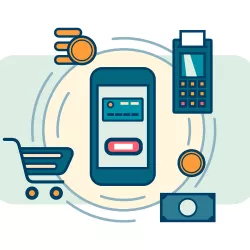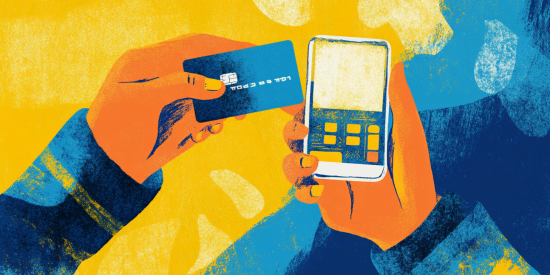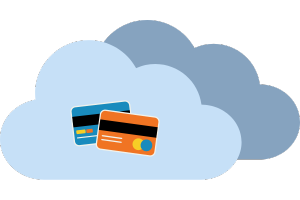With evidence suggesting that 87% of consumers prefer NFC mobile payments for in-store purchases, it’s no wonder businesses are rushing to offer this payment method.[1] Grand View Research. “Mobile Payment Market Size, Share & Trends Analysis Report By Technology (Near Field Communication, Direct Mobile Billing), By Payment Type (B2B, B2C, B2G), By Location, By End Use, By Region, And Segment Forecasts, 2023 – 2030.” Accessed October 03, 2024. As EMV chips began to feature in cards more regularly and contactless transactions became possible, near-field communication (NFC) payments became popular. Mobile phones, such as iPhones and Android devices, began offering NFC payment options, allowing phone users to upload credit card details and pay using mobile wallets.

This guide explores NFC mobile payments, how NFC payments work, the pros and cons of NFC payments, examples of businesses using NFC for mobile payments, and other related topics. Read ahead if you want to learn about one of the world’s fastest-growing payment options!
What are NFC Mobile Payments?
NFC payments use near-field communication technology to enable secure and contactless transactions between devices, such as smartphones and contactless payment terminals. Users can pay by bringing their mobile device close to a payment terminal without the need for physical contact or swiping cards. Users pre-save their card details on mobile devices and authorize the transaction with a passcode or biometric approval, such as Apple Face ID. With its simplicity and security features, NFC ensures quick, contactless transactions. It’s revolutionized the way consumers and merchants engage in the modern world of digital payments. Estimates suggest there are now 2.8 billion mobile wallets in use worldwide — this payment method shows no signs of slowing down.[2] Statista. “Mobile payments with digital wallets — statistics & facts.” Accessed October 03, 2024.
As a side note, many EMV chip cards facilitate NFC payments, but these are not “NFC mobile payments.”
How do Mobile NFC Payments Work?
So, what is NFC? Near Field Communication (NFC) payments operate on a radio-frequency identification (RFID) platform, fostering seamless communication between devices within a couple of inches. The technology relies on two components: the initiator and the target. The initiator is a mobile device or EMV chip card, while the target is a POS machine, mobile card reader, or any other EMV-enabled payment hardware device. When a user initiates a transaction, the devices establish a secure, short-range connection, sharing encrypted information. NFC utilizes electromagnetic fields for data exchange, making it swift and safe. It employs inductive coupling, where the initiator’s coil creates an electromagnetic field that induces a current in the target’s coil, facilitating data transfer. While this all sounds complicated, it occurs almost instantly.
NFC and Contactless Payments
NFC refers to the communication protocol allowing devices like smartphones to exchange data nearby; contactless payments specifically pertain to transactions made without physical contact between a payment device (like a card or smartphone) and a payment terminal. Contactless payments often use NFC technology, encompassing various methods like RFID, QR codes, etc. Essentially, a contactless payment is any payment method that does not involve physical contact, and NFC payments are a type of contactless payment.
Pros and Cons of Mobile NFC Technology
As with any new payment method, there are pros and cons to accepting mobile NFC payments in your business. Below, let’s explore the advantages and disadvantages in more detail:

Mobile NFC technology pros
- Payment Speed: NFC payments are extremely quick, occurring almost instantly without a PIN or signature. This makes it easier for businesses to serve more customers in a timely manner.
- Extra Security Features: NFC payments provide extra security to merchants by utilizing tokenization and encryption, minimizing the risk of data breaches. With proximity requirements and authentication measures, such as biometrics or PIN entry, NFC enhances transaction security, reducing the likelihood of fraudulent activities and protecting customer and merchant information.
- Popular with Customers: There’s no doubt this payment option is extremely popular with customers. The speed and convenience of NFC payments make purchasing goods and services almost effortless from a consumer standpoint.
- Quicker Card Updates and Replacements: For consumers using mobile wallets, such as Apple Pay or Google Pay, card issuers can instantly update card details for lost or expired cards. This means there’s no need to wait days or weeks to regain access to a credit or debit card.

Mobile NFC technology cons
- Hardware Upgrades Required for Merchants: Hardware upgrades may be expensive if a business doesn’t have access to modern NFC payment systems. A business needs card readers, POS machines, and other devices with NFC capability. For large organizations, this type of upgrade may cost significant money.
- Not Without Security Risks: While there’s no doubt NFC payments offer more security than other payments, hackers are still hard at work trying to steal financial information from individuals. If a hacker gains access to a consumer’s passcode, they may be able to complete payments using a stolen NFC-enabled device.
- Customer’s Hardware is Battery Dependent: If your customer only uses NFC technology, they will depend on their battery life. If a smartphone or NFC device runs out of battery, they cannot complete payment.
Are NFC Mobile Payments Secure?
For the most part, NFC mobile payments are considered secure. NFC employs encryption protocols to safeguard sensitive information during transmission. Tokenization, where a unique token substitutes actual card details, adds an extra layer of security. Likewise, NFC mobile transactions often necessitate user authentication, such as biometrics (Face ID) or passcode entry, enhancing overall payment security. Lastly, the proximity required by NFC mobile payments reduces the risk of unauthorized interception.
However, contactless EMV-card payments are less secure, as they don’t require a passcode or biometric authorization. If someone steals an individual’s card, they can use it for NFC payments until the card is canceled. This is why there are upper limits on the value of charges for card-based NFC payments.
Examples of Businesses that Use NFC for Mobile Payments
With modern consumers demanding payment flexibility from businesses they interact with, many companies now offer NFC payment options. Let’s explore some examples of popular US businesses using this payment method:
- Apple Store
- Bloomingdale’s
- Champs Sports
- Chevron
- Coca-Cola Vending Machines
- Disney Store
- Firehouse Subs
- Foot Locker
- GameStop
- Jamba Juice
- JetBlue
- Nike
- McDonald’s
- Office Depot
- OfficeMax
- Staples
- Subway
- Texaco
- Walgreens
- Walt Disney World
- Whole Foods Market
Above is just a small sample of businesses in the United States using NFC technology. As you can see, some of the country’s largest brands are taking advantage of this payment method.
Types of Devices and Apps that Support Mobile NFC Technology
Fortunately, it’s not hard to find hardware and apps supporting mobile NFC technology. Below, let’s explore some examples of devices and software platforms your business can use to facilitate contactless payments:

Mobile card readers
Mobile card readers are portable devices that read cards. Some work independently, while others connect to smartphones or tablets through Bluetooth, auxiliary cables, or other methods. Many modern card readers allow for contactless, chip, and swipe payments. They’re one of the most affordable options for accepting contactless payments from customers.

Modern POS systems
It’s not just mobile card readers that accept NFC payments; most modern POS systems also offer NFC payment options to merchants. Don’t choose a POS provider without NFC payments, as upgrading in the future may be costly.

Apple Pay
Apple Pay is a mobile payment solution designed for iPhones and iPads. It allows users to pay for products in person, online, and via apps. Regarding NFC payments, Apple Pay allows users to store card data and process contactless payments using their device passcode or Face ID.

Google Pay
Google Pay is similar to Apple Pay but for Android devices. It facilitates NFC payments for Android mobile devices, ensuring users can pre-save card details and benefit from contactless payments at participating merchants.

Merchant service providers
Many merchant service providers connect business owners with software and hardware for NFC payments. If you work with a merchant service provider to process payments in your business, a dedicated account manager will help you identify the best mobile NFC technology on the market. Many merchant service providers can integrate NFC technology with other systems, such as POS systems, merchant accounts, payment security tools, and more. It’s the best way to access a full payment stack in a single location.

Why should I accept NFC mobile payments?
There are many reasons your business must consider offering NFC payments to customers. Firstly, NFC technology enhances the overall customer experience by offering a swift and convenient payment method. The streamlined process accelerates transactions, reducing wait times and fostering customer satisfaction. Additionally, embracing NFC aligns with contemporary consumer preferences for contactless transactions, especially pertinent in a world increasingly focused on hygiene and efficiency. Implementing NFC payments can attract tech-savvy customers, positioning the business as technologically forward-thinking.
From an operational standpoint, NFC payments offer a range of advantages, beginning with the ability to streamline accounting processes significantly. By reducing the need to handle physical cash, businesses can minimize the potential for errors related to manual cash handling and improve the overall accuracy of their financial records. In addition, this reduction in cash dependency can lead to faster transaction times, enabling employees to focus on other important tasks.
Moreover, integrating NFC payments keeps pace with evolving consumer preferences, particularly as more people favor contactless and digital payment methods, and enhances operational efficiency across the board. By adopting NFC technology, businesses can process payments more swiftly, reduce the risk of fraud associated with traditional card payments, and create a seamless customer experience. As a result, both employees and customers benefit from a smoother, more modern payment process that supports business growth.
This, in turn, fosters customer loyalty and strengthens the business’s modern image. Ultimately, adopting NFC payments offers a comprehensive benefit to operational functionality and customer engagement.
How to Implement NFC and Mobile Payment Systems

Now that you know the benefits of NFC and mobile payments, you might ask: How can I use this in my business? Thankfully, even though NFC technology is advanced, setting up contactless payments is easier than ever. Start by contacting a merchant service provider to get started with NFC mobile payments.
A merchant service provider will assess your business’s size, needs, and capabilities to determine the most suitable NFC system. You’ll receive a dedicated account manager tasked with helping your business get the most from its new payment stack. Consumers are 63% more likely to shop at businesses offering their preferred payment method, so you can’t afford to miss out on NFC transactions.
So, what are you waiting for? Contact a merchant service provider today and upgrade your payment system!
Frequently Asked Questions
Is NFC the same as tap-to-pay?
No, the “NFC meaning” is the technology underlying tap-to-pay. Near-field communication (NFC) lets mobile devices and EMV cards connect wirelessly to payment devices like mobile card readers. While tap-to-pay is the most common use of NFC, this technology can also be used for wireless charging of mobile devices.
Is PayPal NFC mobile payment?
Merchants who use PayPal iZettle for in-person transactions can easily accept NFC payments from their customers, making it a convenient option for contactless payments. However, there is a limitation when it comes to using PayPal for mobile-based NFC transactions. While PayPal can be used to pay for products online, it cannot be linked to Apple Pay or Google Pay. This means that customers cannot use their PayPal balance to make NFC payments directly through their mobile phones. As a result, while PayPal offers many payment solutions, it falls short of fully supporting mobile NFC transactions.
Is NFC the same as Google Wallet?
No, NFC is a technology that enables short-range wireless communication between devices commonly used for contactless payments. Google Wallet, on the other hand, was a mobile payment system developed by Google. It utilized NFC for transactions but also included additional features like peer-to-peer payments. Google Wallet has since been rebranded and integrated into Google Pay, supporting NFC payments and other payment methods.
Can I add NFC to a non-NFC phone?
This depends on whether you’re a merchant or a customer. If you’re a customer, you cannot add NFC payment capabilities to a phone without it. Fortunately, most modern smartphones have NFC capability, so you shouldn’t have to break the bank to upgrade to an option with contactless payments. However, if you are a merchant, you can upgrade some non-NFC phones to accept NFC payments. For example, Bluetooth-enabled mobile card readers can connect to your mobile device and process NFC payments from customers.
Can you pay with NFC without the Internet?
NFC payments can be processed without the need for an internet connection, as the transaction data is exchanged locally between the NFC-enabled devices in close proximity.







